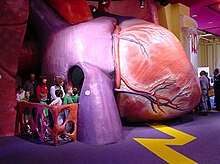The Giant Heart

The Giant Heart exhibit, originally called the "Engine of Life" exhibit, is one of the most popular and notable exhibits at the Franklin Institute.[1] Built in 1953, the exhibit is roughly two stories tall and 35-feet in diameter. A walk-through exhibit, visitors can explore the different areas of the heart.[2]
Visiting The Giant Heart has become a tradition or "right of passage" for many school-aged children, particularly on field trips, in the Philadelphia-area.
History
[edit]The original idea for the walk-through heart exhibit came from Dr. Mildred Pfeiffer, a physician and Director of Cardiovascular Diseases at the Pennsylvania Department of Health who would travel giving lectures about the heart and heart health; she proposed the idea of the heart in an effort to have a centralized resource that people could visit and learn of the heart.[3][4] The original materials used to construct the heart were papier-mâché, chicken wire and lumber.
The Giant Heart was supposed to have only been on display for six months.[5] It was the idea of physician Mildred Pfeiffer, who designed The Giant Heart with a medical illustrator and engineer.[5] It was originally made out of wood, chicken wire and papier-mâché.[5] However, The Giant Heart became a popular attraction and the Franklin Institute opted to keep it. More than 70 years later, it remains one of the most visited exhibits at The Franklin Institute.[5]
Features
[edit]The Giant Heart is 100 times larger than the average human heart.[5] As visitors walk-through The Giant Heart there is signage pointing out which part of the "heart" they are walking past.[5]
The deeper visitors walk deeper into the heart, the sound of a heartbeat gets louder and louder.[5] The sound of the heartbeat was originally computer generated, but as part of the 2019 renovations, it was replaced by the sound of a real human heartbeat.[5]
Stephanie Farr writing in The Philadelphia Inquirer said that The Giant Heart has a "universally recognized-but-hard-to-define odor."[5]
Located next to The Giant Heart is the Bio-science exhibit, which aims to teaching and sparking interest among visitors in the science of the human body.
Renovation
[edit]In 1979, The Giant Heart was rebuilt with fiberglass.[5] The Giant Heart was remodeled and updated in 2004 and 2019.[6]
References
[edit]- ^ "The History of the Giant Heart | The Franklin Institute". www.fi.edu. Retrieved 2016-03-02.
- ^ Bogle, Elizabeth Bogle (2013). Museum Exhibition Planning and Design. AltaMira Press. ISBN 978-0759122307.
- ^ "Human Heart Episcopal Hospital Diseases". The Philadelphia Inquirer. Archived from the original on October 18, 2015. Retrieved 2018-11-29.(subscription required)
- ^ "Heartthrob Of Museum Beats Cleanly Once Again". philly-archives. Archived from the original on January 4, 2016. Retrieved 2016-03-02.(subscription required)
- ^ a b c d e f g h i j "A rescue, canoodling, and that smell: Philly's tales from the Franklin Institute's Giant Heart, which just got a makeover". The Philadelphia Inquirer. Retrieved 23 February 2024.
- ^ "The Giant Heart | The Franklin Institute Science Museum". www.fi.edu. Retrieved 2016-03-02.
